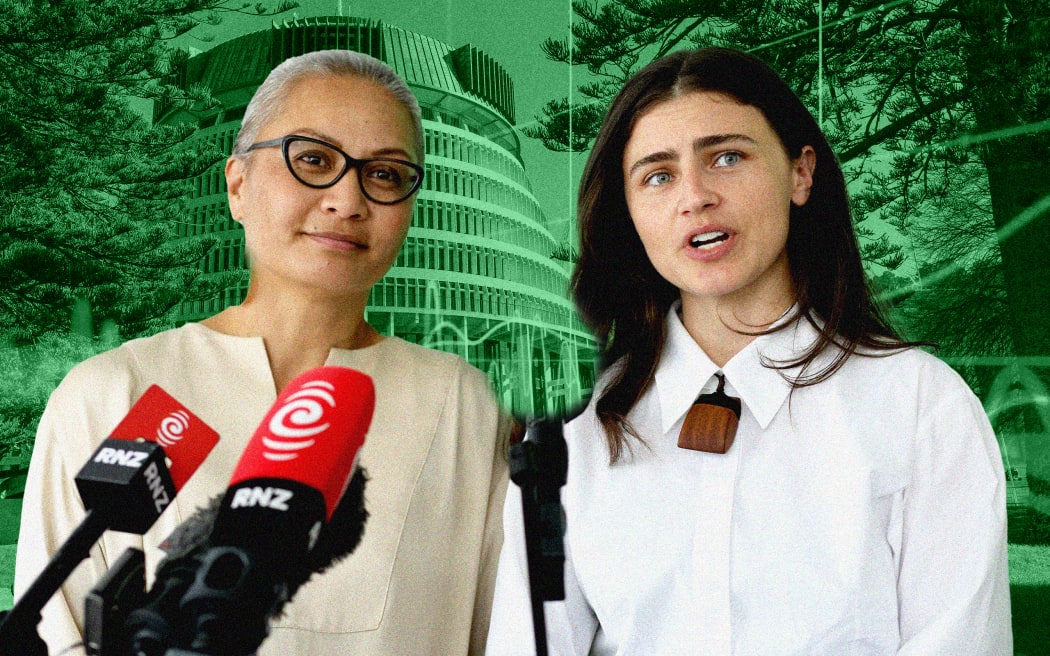
Green Party co-leaders Marama Davidson and Chlöe Swarbrick spoke at the party's AGM over the weekend. (File photo) Photo: RNZ
Analysis: The most telling line out of the Green Party's AGM this weekend was not its claim to be leading the opposition, nor its ambitions on leading the next government.
Such lofty goals are to be expected as all parties try to motivate members at their annual conferences.
More interesting was an observation from co-leader Marama Davidson, dropped almost as an afterthought near the end of Sunday's media conference.
"Setting the agenda isn't just about numbers," she said. "We've got a government right now whose tail is being wagged by two smaller parties."
The subtext is clear: if ACT and NZ First can have a disproportionate influence - as David Seymour likes to put it - then why not the Greens, alongside perhaps, Te Pāti Māori?
That framing is politically dangerous for Labour.

Labour leader Chris Hipkins. (File photo) Photo: RNZ / Mark Papalii
National will seize on it, warning of a Labour government beholden to its minor partners. Remember previous attempts to tie Labour to the Greens' wealth tax.
Those attacks might be undermined somewhat by the coalition's own tensions, but they will be aided by Labour's current policy paucity.
If Labour's manifesto remains light on detail for too long, the Greens could end up setting the agenda and the terms of debate by default.
That's where the Greens' claim of opposition dominance has some merit.
They have pumped out a suite of detailed policies on tax, climate, and industrial strategy this term while Labour has deliberately kept its powder dry.
Co-leader Chlöe Swarbrick pointed to this year's Budget Day, claiming ministers spent most of their time talking about the Green Budget.

Davidson and Swarbrick on stage at the party's AGM over the weekend. Photo: RNZ/Anneke Smith
But that also proves the problem for Labour: Hipkins and finance spokesperson Barbara Edmonds spent weeks after the Budget being questioned about the Greens' plan to their obvious frustration.
They won't be thrilled by Swarbrick advocating herself as the next finance minister over the weekend either.
Labour will look to correct the imbalance as the election gets closer. But in the meantime, it risks losing support to the Greens' big talk.
Monday's Taxpayers' Union-Curia poll suggests that has not happened yet.
The poll records Labour on 33.6 percent - the most popular party in Parliament - with the Greens just under 10 percent, more than 20 points behind.
That severely undercuts the Greens' self-styled role as the main force on the centre-left.
However, look deeper and the polling shows voters are lukewarm on all party leaders. Christopher Luxon and Chris Hipkins are level-pegging as preferred prime minister, but on numbers that would have been considered dire in previous cycles.

Christopher Luxon and Chris Hipkins are level-pegging as preferred prime minister. (File photo) Photo: RNZ
In that environment, a smaller party talking up its ability to call the shots could help mobilise its supporters - or it could alienate swing voters wary of instability.
Both would be a concern for Labour, though again, a similar tension will play out on the centre-right as well.
Swarbrick's push for the Green Party to reach beyond its comfort zone - to miners, mill workers, even farmers - recognises the need to expand its base.
The question is whether those voters can realistically be convinced to back a party long associated with a different set of priorities and values.
For now, the Greens remain what they've been for years: a minor party with a loyal base and a clear agenda.
Their claims on leading the opposition are more marketing than reality. Still, in a race this tight, marketing might make the difference.
Sign up for Ngā Pitopito Kōrero, a daily newsletter curated by our editors and delivered straight to your inbox every weekday.







